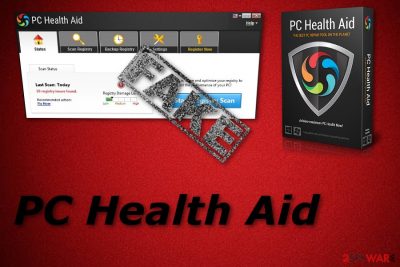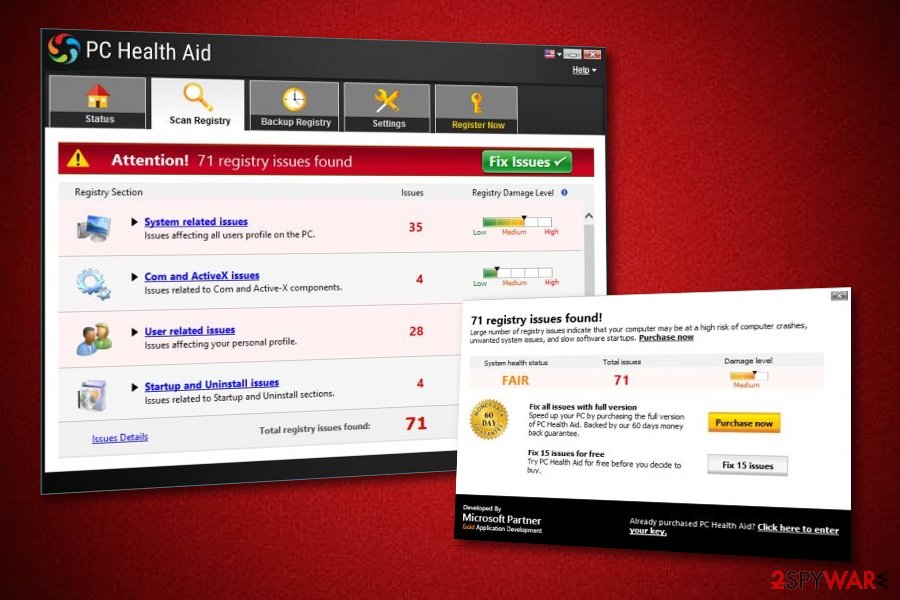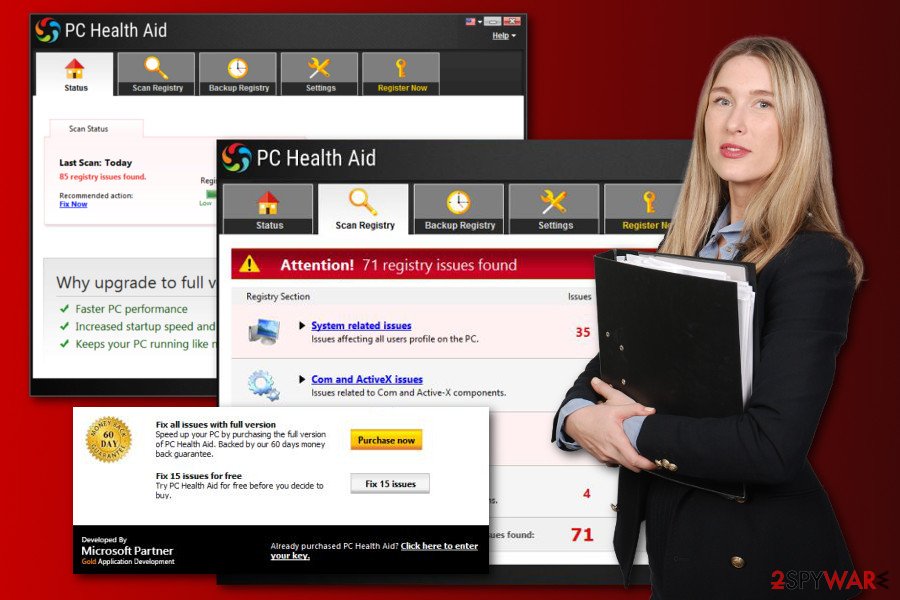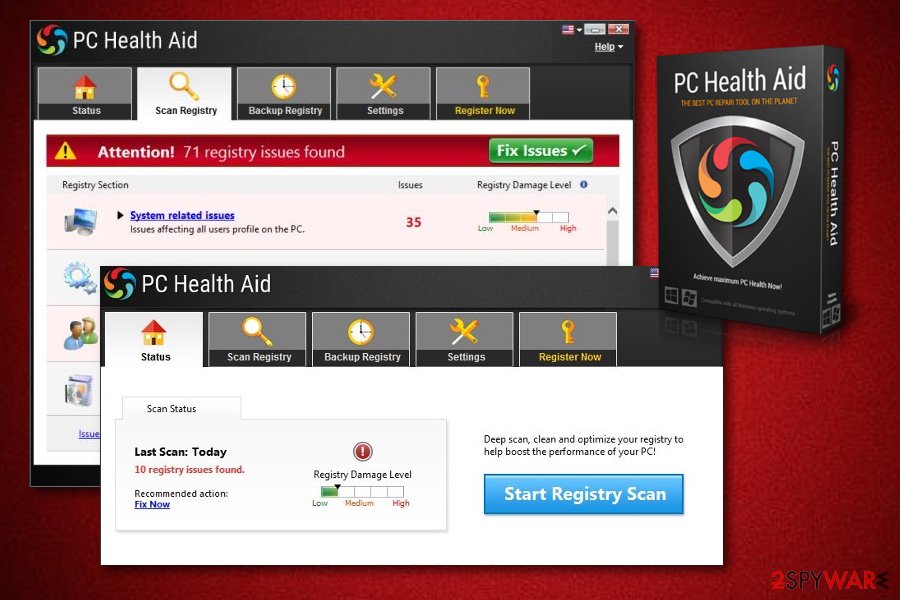PC Health Aid virus (Tutorial) - updated Mar 2017
PC Health Aid virus Removal Guide
What is PC Health Aid virus?
PC Health Aid virus – a system optimizer which tries to trick users by displaying fake alerts

PC Health Aid, created by Comguard Solutions, is a system optimization tool that is categorized as a potentially unwanted program (PUP)[1]. The official website of the program claims that it is “the best PC health tool on earth” that is supposed to accelerate the system speed, stabilize computer’s performance, backup registry, detect and fix various computer issues, and protect data. However, it truly does alerts about various system issues but such messages appear to be false and are used only to scare victims. For “fixing”, PC Health Aid virus offers to purchase the full version of the program. Be careful and do not fall for such tricks. If you want to re-check your computer system, get a reliable anti-malware tool and perform a scan with that program. You should see that there are barely any results similar to those provided by PC Health Aid tool.
| Name | PC Health Aid |
|---|---|
| Type | System tool |
| Sub-type | PUP |
| Purpose | To convince users to buy the licensed version of the tool |
| Symptoms | You keep seeing pop-ups and alerts related to this program |
| Distribution | Official website, other programs |
| Prevention | Use the Custom/Advanced installation mode only, stay away from rogue sites, download antivirus protection |
| What to do | Install FortectIntego to scan the system for detecting PUP-related issues |
One of the reasons why PC Health Aid system tool has been classified as a PUP is that many antivirus programs detect it as a Trojan[2] or adware.[3] Another reason is related to its distribution method. This tool spreads bundled with other software; thus, it might seem to appear on the computer out of nowhere.
Some good news is that PC Health Aid fake system tool cannot harm the system, but it can certainly cause annoying activities. When installed on the computer, this tool starts scanning the system looking for various errors and issues that need to be fixed. Once it finds, it presents scan results and offers to buy a full version to fix these problems.

Thus, this program has two versions. The free version works as a scanner and is mostly distributed with freeware or shareware. This technique helps to promote the paid version of the program. Finding out about computer-related programs might not be pleasant, and some people might be interested in buying it. Better remove PC Health Aid virus as it will not fix any computer-related problems. We recommend scanning the PC with FortectIntego
However, if the scan results appeared out of the blue and you haven’t installed this program yourself, you should think twice whether you can rely on this program or not. Though, we do not recommend buying a full version. If you think that you need a PC optimization tool, look for more reliable applications or try other methods to speed up your computer[4] after the PC Health Aid removal.

Before installing new programs, you should always read the Privacy Policy and EULA to learn what you can expect from it.[5] The most important parts of these documents are data collection and partnership with third-parties. When you decide to install PC Health Aid, you agree that developers collect particular information about you and, in some cases, share aggregated data with third-parties.
The program might collect information such as IP address, the type, and version of the browser and operating system, etc. What is more, they may use tracking cookies to get information about downloaded, installed or uninstalled the software. According to the Privacy Policy, this information might be shared with vendors, consultants, and other service providers. This information is supposed to help to improve their services; however, it might also be used for marketing purposes.
Fake system tools distribute secretly
According to IT specialists from NoVirus.uk[6], fake system optimization tools have an official website where people can purchase, download and install them. However, it’s not the only one way how such programs might end up on the computers. These type of applications might also be added to the software packages[7] and offered to download as an optional component.
The problem is that the majority of computer users rely on Basic or Standard installation settings when installing freeware or shareware. These settings do not reveal whether you install a package or a single program. Thus, if it was a package, you might encounter not only PC Health Aid hijack but allow other potentially unwanted programs to enter the system.
In order to avoid PUPs, you need to install new programs under Advanced or Custom settings. However, do not rush to click the “Next” button. Slowly and attentively follow each step and look for the list of pre-selected entries. Once you find them, deselect all programs offered to you.
Remove PC Health Aid virus

You can remove PC Health Aid virus from the computer easily. The simplest method suggests to go to the Programs folder and search for the program. Then, click “Uninstall PC Health Aid” option and wait for the uninstall guide to launch. Furthermore, you can try using expert-suggested anti-malware programs and getting rid of the potentially unwanted program automatically.
After the PC Health Aid removal, we also recommend scanning the computer with a reputable anti-malware program, such as FortectIntego. This step is extremely important if this program came into your PC bundled with other software. It is possible that other potentially unwanted programs have been installed without your knowledge too. Thus, you need to remove them as well.
You may remove virus damage with a help of FortectIntego. SpyHunter 5Combo Cleaner and Malwarebytes are recommended to detect potentially unwanted programs and viruses with all their files and registry entries that are related to them.
Getting rid of PC Health Aid virus. Follow these steps
Uninstall from Windows
Delete all unwanted components that might have been added by the system tool. Use these instructions for your Windows OS:
Instructions for Windows 10/8 machines:
- Enter Control Panel into Windows search box and hit Enter or click on the search result.
- Under Programs, select Uninstall a program.

- From the list, find the entry of the suspicious program.
- Right-click on the application and select Uninstall.
- If User Account Control shows up, click Yes.
- Wait till uninstallation process is complete and click OK.

If you are Windows 7/XP user, proceed with the following instructions:
- Click on Windows Start > Control Panel located on the right pane (if you are Windows XP user, click on Add/Remove Programs).
- In Control Panel, select Programs > Uninstall a program.

- Pick the unwanted application by clicking on it once.
- At the top, click Uninstall/Change.
- In the confirmation prompt, pick Yes.
- Click OK once the removal process is finished.
Delete from macOS
Remove items from Applications folder:
- From the menu bar, select Go > Applications.
- In the Applications folder, look for all related entries.
- Click on the app and drag it to Trash (or right-click and pick Move to Trash)

To fully remove an unwanted app, you need to access Application Support, LaunchAgents, and LaunchDaemons folders and delete relevant files:
- Select Go > Go to Folder.
- Enter /Library/Application Support and click Go or press Enter.
- In the Application Support folder, look for any dubious entries and then delete them.
- Now enter /Library/LaunchAgents and /Library/LaunchDaemons folders the same way and terminate all the related .plist files.

Remove from Microsoft Edge
You can clean the Microsoft Edge browser by removing all unwanted components with the help of these guidelines:
Delete unwanted extensions from MS Edge:
- Select Menu (three horizontal dots at the top-right of the browser window) and pick Extensions.
- From the list, pick the extension and click on the Gear icon.
- Click on Uninstall at the bottom.

Clear cookies and other browser data:
- Click on the Menu (three horizontal dots at the top-right of the browser window) and select Privacy & security.
- Under Clear browsing data, pick Choose what to clear.
- Select everything (apart from passwords, although you might want to include Media licenses as well, if applicable) and click on Clear.

Restore new tab and homepage settings:
- Click the menu icon and choose Settings.
- Then find On startup section.
- Click Disable if you found any suspicious domain.
Reset MS Edge if the above steps did not work:
- Press on Ctrl + Shift + Esc to open Task Manager.
- Click on More details arrow at the bottom of the window.
- Select Details tab.
- Now scroll down and locate every entry with Microsoft Edge name in it. Right-click on each of them and select End Task to stop MS Edge from running.

If this solution failed to help you, you need to use an advanced Edge reset method. Note that you need to backup your data before proceeding.
- Find the following folder on your computer: C:\\Users\\%username%\\AppData\\Local\\Packages\\Microsoft.MicrosoftEdge_8wekyb3d8bbwe.
- Press Ctrl + A on your keyboard to select all folders.
- Right-click on them and pick Delete

- Now right-click on the Start button and pick Windows PowerShell (Admin).
- When the new window opens, copy and paste the following command, and then press Enter:
Get-AppXPackage -AllUsers -Name Microsoft.MicrosoftEdge | Foreach {Add-AppxPackage -DisableDevelopmentMode -Register “$($_.InstallLocation)\\AppXManifest.xml” -Verbose

Instructions for Chromium-based Edge
Delete extensions from MS Edge (Chromium):
- Open Edge and click select Settings > Extensions.
- Delete unwanted extensions by clicking Remove.

Clear cache and site data:
- Click on Menu and go to Settings.
- Select Privacy, search and services.
- Under Clear browsing data, pick Choose what to clear.
- Under Time range, pick All time.
- Select Clear now.

Reset Chromium-based MS Edge:
- Click on Menu and select Settings.
- On the left side, pick Reset settings.
- Select Restore settings to their default values.
- Confirm with Reset.

Remove from Mozilla Firefox (FF)
Remove dangerous extensions:
- Open Mozilla Firefox browser and click on the Menu (three horizontal lines at the top-right of the window).
- Select Add-ons.
- In here, select unwanted plugin and click Remove.

Reset the homepage:
- Click three horizontal lines at the top right corner to open the menu.
- Choose Options.
- Under Home options, enter your preferred site that will open every time you newly open the Mozilla Firefox.
Clear cookies and site data:
- Click Menu and pick Settings.
- Go to Privacy & Security section.
- Scroll down to locate Cookies and Site Data.
- Click on Clear Data…
- Select Cookies and Site Data, as well as Cached Web Content and press Clear.

Reset Mozilla Firefox
If clearing the browser as explained above did not help, reset Mozilla Firefox:
- Open Mozilla Firefox browser and click the Menu.
- Go to Help and then choose Troubleshooting Information.

- Under Give Firefox a tune up section, click on Refresh Firefox…
- Once the pop-up shows up, confirm the action by pressing on Refresh Firefox.

Remove from Google Chrome
If you have found any dubious-looking add-ons in your Google Chrome browser, make sure that you get rid of them as soon as possible. Use these steps as guidance:
Delete malicious extensions from Google Chrome:
- Open Google Chrome, click on the Menu (three vertical dots at the top-right corner) and select More tools > Extensions.
- In the newly opened window, you will see all the installed extensions. Uninstall all the suspicious plugins that might be related to the unwanted program by clicking Remove.

Clear cache and web data from Chrome:
- Click on Menu and pick Settings.
- Under Privacy and security, select Clear browsing data.
- Select Browsing history, Cookies and other site data, as well as Cached images and files.
- Click Clear data.

Change your homepage:
- Click menu and choose Settings.
- Look for a suspicious site in the On startup section.
- Click on Open a specific or set of pages and click on three dots to find the Remove option.
Reset Google Chrome:
If the previous methods did not help you, reset Google Chrome to eliminate all the unwanted components:
- Click on Menu and select Settings.
- In the Settings, scroll down and click Advanced.
- Scroll down and locate Reset and clean up section.
- Now click Restore settings to their original defaults.
- Confirm with Reset settings.

Delete from Safari
Remove unwanted extensions from Safari:
- Click Safari > Preferences…
- In the new window, pick Extensions.
- Select the unwanted extension and select Uninstall.

Clear cookies and other website data from Safari:
- Click Safari > Clear History…
- From the drop-down menu under Clear, pick all history.
- Confirm with Clear History.

Reset Safari if the above-mentioned steps did not help you:
- Click Safari > Preferences…
- Go to Advanced tab.
- Tick the Show Develop menu in menu bar.
- From the menu bar, click Develop, and then select Empty Caches.

After uninstalling this potentially unwanted program (PUP) and fixing each of your web browsers, we recommend you to scan your PC system with a reputable anti-spyware. This will help you to get rid of PC Health Aid registry traces and will also identify related parasites or possible malware infections on your computer. For that you can use our top-rated malware remover: FortectIntego, SpyHunter 5Combo Cleaner or Malwarebytes.
How to prevent from getting system tools
Protect your privacy – employ a VPN
There are several ways how to make your online time more private – you can access an incognito tab. However, there is no secret that even in this mode, you are tracked for advertising purposes. There is a way to add an extra layer of protection and create a completely anonymous web browsing practice with the help of Private Internet Access VPN. This software reroutes traffic through different servers, thus leaving your IP address and geolocation in disguise. Besides, it is based on a strict no-log policy, meaning that no data will be recorded, leaked, and available for both first and third parties. The combination of a secure web browser and Private Internet Access VPN will let you browse the Internet without a feeling of being spied or targeted by criminals.
No backups? No problem. Use a data recovery tool
If you wonder how data loss can occur, you should not look any further for answers – human errors, malware attacks, hardware failures, power cuts, natural disasters, or even simple negligence. In some cases, lost files are extremely important, and many straight out panic when such an unfortunate course of events happen. Due to this, you should always ensure that you prepare proper data backups on a regular basis.
If you were caught by surprise and did not have any backups to restore your files from, not everything is lost. Data Recovery Pro is one of the leading file recovery solutions you can find on the market – it is likely to restore even lost emails or data located on an external device.
- ^ Potentially unwanted program. Wikipedia. The free encyclopedia.
- ^ What is a Trojan Virus?. PC Tools. The website for downloading performance & utilities software for Windows.
- ^ Adware. Computer Hope. Free computer help and information.
- ^ PC Cleaning Apps are a Scam: Here’s Why (and How to Speed Up Your PC). How-to Geek. Includes help, tutorials, tips and how-to guides for Windows and Linux.
- ^ A Closer Look at EULAs. Lavasoft. The official website of the Lavasoft antivirus.
- ^ NoVirus.uk. NoVirus. Malware removal tips.
- ^ Vangie Beal. Software package. Webopedia. Online Tech Dictionary for IT Professionals.























